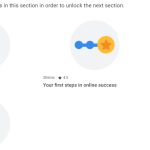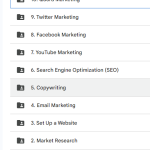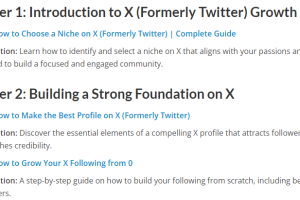Everything You Need to Know to Pick the Perfect Niche
The majority of people looking to grow their audience on Twitter are often unaware of their niche. If you want to start building an audience, identifying your niche is crucial. If you’re unsure how to pick one, don’t worry—I’m here to help.
I’ll share a personal technique that helped me find my own niche when I began my Twitter journey.
Introducing the “4-3-2-1-0” Technique
This simple method can help anyone identify their niche. Here’s how it works:
Step 1: Identify Your Four Strengths
The first step in finding your niche is to identify your four main strengths or areas of expertise. These should be topics that you are knowledgeable about and passionate about discussing. Your strengths could be related to your profession, hobbies, or personal interests.
Example:
- Reading
- Writing
- Marketing
- Watching Movies
Detailed Approach:
- Self-Reflection: Take some time to reflect on what you enjoy doing in your free time and what you have received compliments or recognition for.
- Feedback from Others: Ask friends, family, and colleagues what they think your strengths are. Sometimes others can see strengths that you might overlook.
- Professional and Personal Achievements: Look at your past achievements in both your career and personal life. What were the common themes?
Step 2: List Three Subtopics for Each Strength
Once you have identified your four strengths, list three subtopics for each. These subtopics should be specific areas within your main topics that you can talk about in detail. This step helps you to narrow down your strengths and identify where you can provide the most value.
Example:
- Reading: Genres, Book Reviews, Reading Techniques
- Writing: Creative Writing, Technical Writing, Blogging
- Marketing: Digital Marketing, Social Media, SEO
- Watching Movies: Movie Reviews, Film Genres, Cinematography
Detailed Approach:
- Brainstorming: Write down everything that comes to mind when you think about each strength. Don’t filter yourself; just get all your ideas on paper.
- Prioritize Specificity: Choose subtopics that are specific rather than broad. This will help you to stand out and attract a targeted audience.
- Use Tools for Ideas: Use tools like Google’s autocomplete, keyword planners, and content idea generators to help identify subtopics that are in demand.
Step 3: Narrow Down to Two Topics
Now, from your list of subtopics, identify which topics you filled out the fastest and narrow down to two. These two topics should be the ones you are most knowledgeable about and can easily create content for.
Example:
- Marketing
- Writing
Detailed Approach:
- Speed of Ideas: Notice which topics you could come up with subtopics for the fastest. These are likely the areas where you have the most expertise and passion.
- Interest and Passion: Ensure that the topics you choose are ones you are genuinely interested in and passionate about. This will keep you motivated in the long run.
- Market Demand: Use tools like Google Trends and social media analytics to see which topics are trending and have a high demand.
Step 4: Choose the One in Demand
Now it’s time to pick the winner. A niche should be a single area of expertise, but here you have two options. You need to decide whether to combine these two topics into one niche or select the one that is in higher demand.
Example:
- Combine: Marketing for Writers
- Pick One: Marketing
Detailed Approach:
- Combination: If you find that there is a unique intersection between your two topics, consider combining them. For example, “Marketing for Writers” could be a niche if there is enough interest in this area.
- Demand Analysis: Research the demand for each topic using SEO tools, social media insights, and industry reports. Look at search volumes, engagement rates, and audience size.
- Competitive Analysis: Evaluate the competition in each niche. High competition means there is demand, but it also means you need to find a way to differentiate yourself.
Step 5: Recognize Point “0” and Start Creating Content
Now that you have chosen your niche, it’s time to start creating content. This step is about taking action and establishing your presence in your chosen niche. Begin by talking about all aspects of your niche and providing valuable content to your audience.
Example:
- Marketing: Create content about sales strategies, funnel building, copywriting, lead generation, etc.
Detailed Approach:
- Content Plan: Develop a content plan that outlines what types of content you will create (e.g., blog posts, videos, tweets) and how often you will publish.
- Content Calendar: Use a content calendar to schedule your posts and ensure you remain consistent.
- Diverse Content: Create a variety of content formats to keep your audience engaged. For example, mix educational content with entertaining content.
- Engagement: Engage with your audience by responding to comments, asking for feedback, and participating in relevant discussions.
- Continuous Learning: Keep learning about your niche and stay updated with the latest trends. This will help you to provide fresh and valuable content.
Additional Tips for Choosing Your Niche
- Evaluate Your Interests and Passions: Consider what you enjoy doing and talking about. A niche you’re passionate about will keep you motivated.
- Research Market Demand: Use tools like Google Trends, keyword planners, and social media platforms to see what topics are currently popular.
- Analyze Competitors: Look at what successful influencers in your potential niches are doing. Learn from their strategies and identify gaps you can fill.
- Test and Iterate: Start creating content in a few areas of interest and see what resonates most with your audience. Be flexible and willing to adjust your focus based on feedback.
- Seek Feedback: Ask your followers, friends, or mentors for their opinions on your chosen niche. They might offer valuable insights you hadn’t considered.
- Consider Your Skills: Think about what skills you have that can add value to your chosen niche. This could be technical expertise, creative abilities, or professional experience.
- Long-Term Viability: Ensure your chosen niche has the potential for long-term growth and sustainability. Avoid fads that might fade away quickly.
- Monetization Potential: Consider how you can monetize your content in your chosen niche. Look for opportunities such as sponsorships, affiliate marketing, and selling products or services.
Practical Steps to Implement the “4-3-2-1-0” Technique
- Brainstorm and List: Write down your top four strengths and list three subtopics for each.
- Quick Selection: Identify which topics you filled out quickly and narrow down to two.
- Research Demand: Use online tools to determine the demand for your final two topics.
- Make Your Choice: Decide whether to combine the topics or pick one based on demand.
- Content Creation: Start producing content in your chosen niche and engage with your audience.
Example Walkthrough
Let’s go through an example using the “4-3-2-1-0” technique:
- Step 1: Four Strengths
- Reading
- Writing
- Marketing
- Watching Movies
- Step 2: Subtopics
- Reading: Genres, Book Reviews, Reading Techniques
- Writing: Creative Writing, Technical Writing, Blogging
- Marketing: Digital Marketing, Social Media, SEO
- Watching Movies: Movie Reviews, Film Genres, Cinematography
- Step 3: Narrow Down to Two
- Marketing
- Writing
- Step 4: Choose One
- Combine: Marketing for Writers
- Pick One: Marketing
- Step 5: Create Content
- Focus on Marketing: Create content about sales strategies, funnel building, copywriting, and lead generation.
By following these steps, you can effectively identify a niche that aligns with your strengths, interests, and market demand. This will help you build a dedicated and engaged audience on Twitter.







[…] Title: How to Choose a Niche on X (Formerly Twitter) | Complete Guide […]